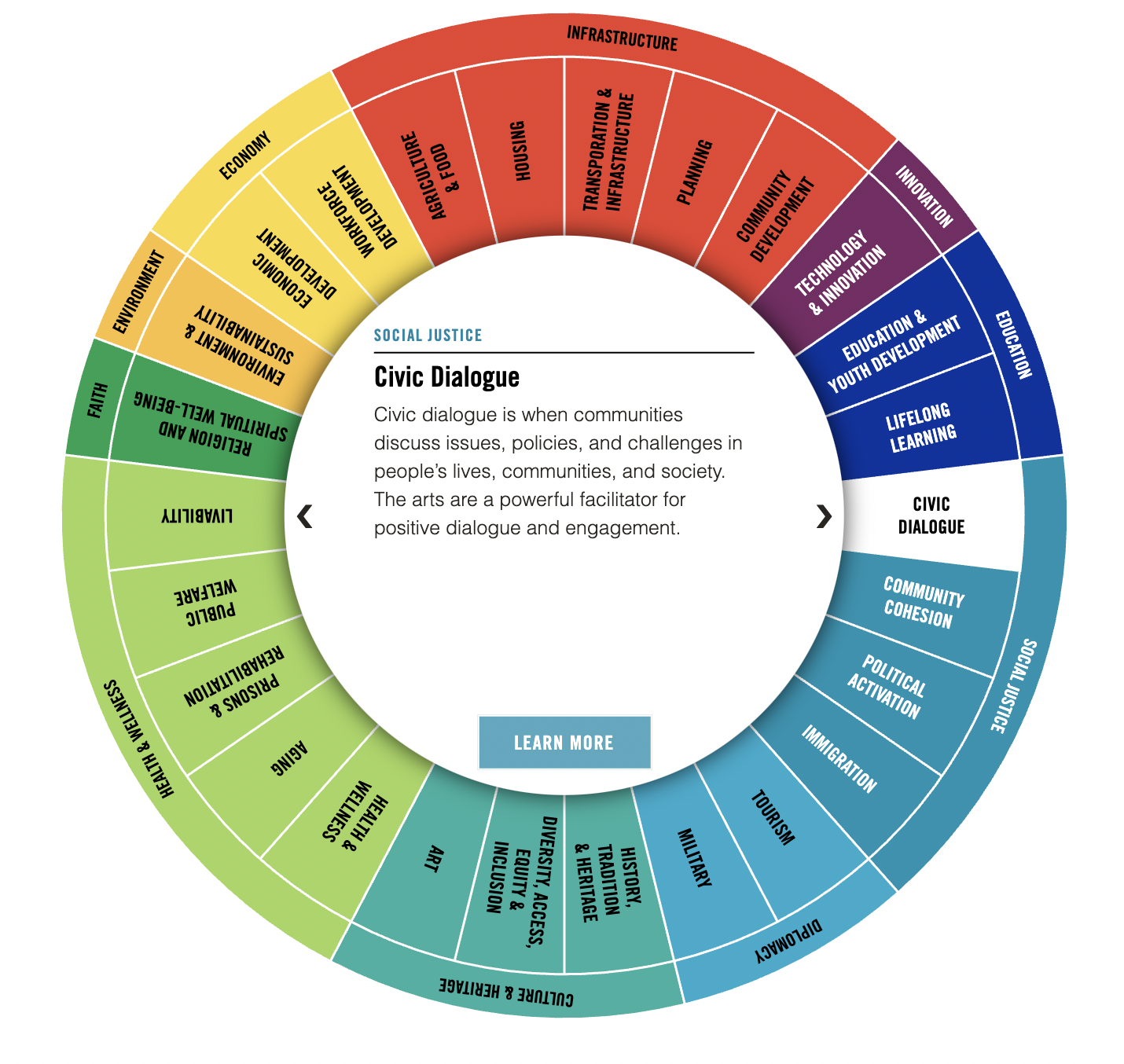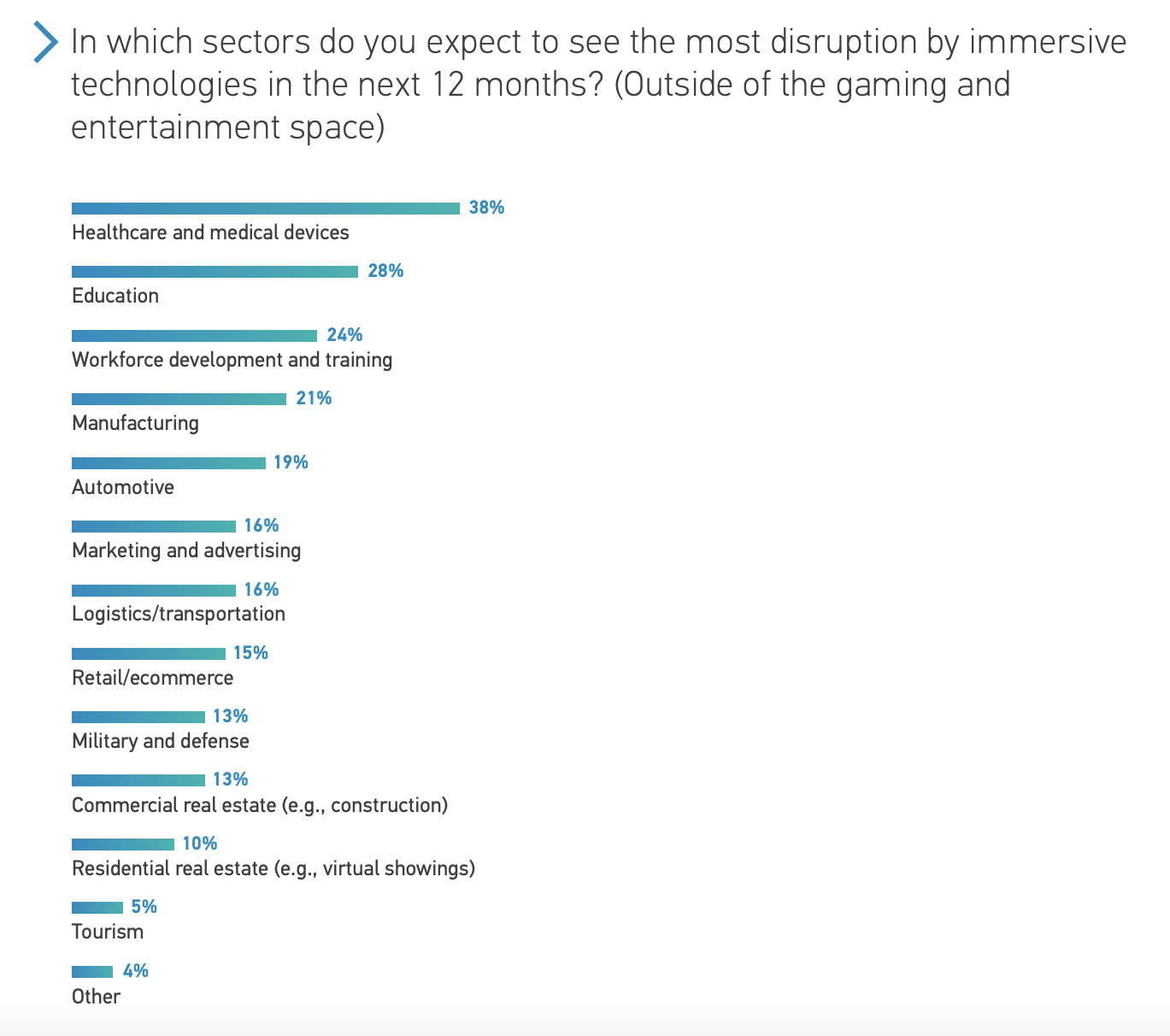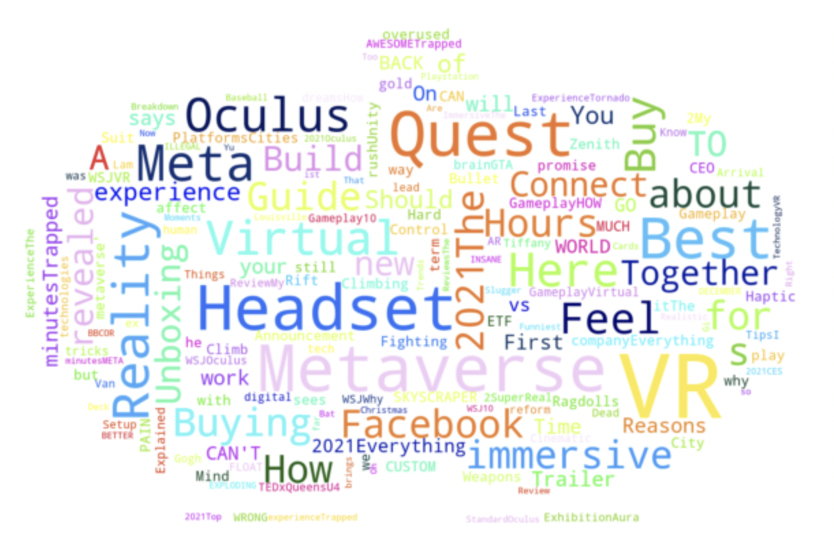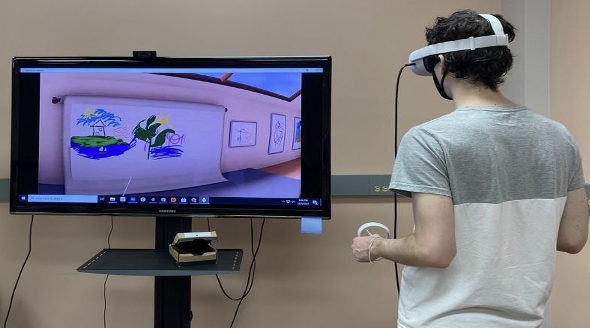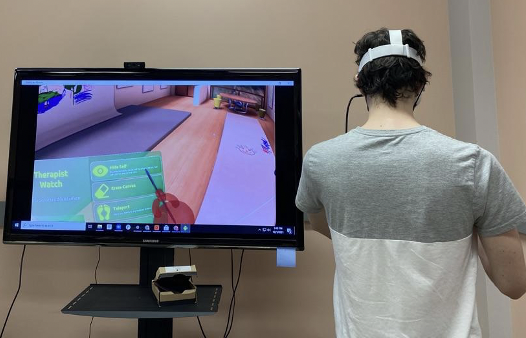The Social Impact Goal
Those who have a vested interest in the arts are often curious: how is art impacting its audiences? The Americans for the Arts Arts + Social Impact Explorer presents ten categories for how art can impact the people in its communities, and it is the ultimate challenge of arts organizations to build innovative programs that improve their reach in all ten. To measure impact against this challenge, organizations may analyze ticket sales, subscriptions, donations, and audience surveys. Between income spreadsheet lines, however, there are more questions about how to improve engagement, and – central to this piece – when and how to incorporate new technologies into classic offerings to boost innovation.
Figure 1: Americans for the Arts Social Impact Explorer. Source: Americans for the Arts
While art’s impact on society cannot be precisely measured, its applications can be used in novel technology as a signal for its direction in our modern world. Virtual Reality (VR) technology is one of these technologies that can be leveraged. VR developers and artists have grown increasingly collaborative in building creative immersive experiences over the past two decades. Meta, formerly Facebook, recently committed to investing $10 billion dollars in VR development in the next year. In light of this massive VR endorsement, this article in VentureBeat explores how art can positively impact health and wellbeing, civic dialogue, and community development when paired with VR technology and art therapy foundations.
“Art, in itself, is an attempt to bring order out of chaos.” - Stephen Sondheim
The Market for Creative VR Has Expanded
VR is most readily associated with gaming in the public domain. Action, adventure, fighting, and combat games are popularly developed within the VR gaming community. However, there is a lot of buzz in the media currently about how VR can impact society outside of providing video-game-type entertainment. The 2020 Augmented and Virtual Reality Survey Report found that the growth of VR will most likely impact the healthcare and education industries most. VR applications are extremely flexible in their building structure, as they have been customized to simulate surgeries for doctors in training, and even Black Friday shoppers to prepare Walmart employees for the biggest shopping day of the year.
Figure 2: Breakdown of VR’s expected sector disruption. Source: 2020 Survey Report.
Meta’s massive commitment to VR development is a means to bold end: building what it calls the “metaverse” and filling it with everything we recognize in our daily lives and more. The metaverse is still very much in its development phase, but its eventual appeal is set to be a virtual world, much like our physical world, where one can navigate work, social, fitness, and commerce. Meta has already begun releasing VR applications on its Oculus Quest 2 that fit these categories so users get exposed to what a world of working or exercising in a 360 virtual landscape would look and feel like. According to a recent YouTube data scrape, the public is focusing on the headset, feel, excitement, and “how-tos” of these experiences so far.
Figure 3: A word cloud built from YouTube video titles related to VR and the metaverse. Image by author.
There are many unknowns in terms of where VR will lead for the average consumer and many conversations to be had about the value of in-person versus virtual experiences that arise from the technology’s further development. Forbes recommends that everyone invest in the metaverse, while some are not so sure that it will catch on. Tom Corbett, a specialty faculty member at Carnegie Mellon University’s Entertainment Technology Center (ETC) likened the current state of the metaverse to where the internet was in the late 1990s when email and limited forums were all the web could provide. “There’s still not a lot to do [in the metaverse], and there’s so much we don’t know about where it is going to go yet,” he says.
Though we are still far from a time when everyone is using VR, promising insights in the realms of art and storytelling in VR indicate how the technology is making an impact on public health and civic dialogue today, and how it can expand this impact in the future. The release of the Oculus Quest 2 in the fall of 2021 was monumental because it marked the most inexpensive VR headset release yet. Consumers can now purchase the headset for $300, and a Facebook account of course. For reference, when VR simulations were first used for trauma related therapy in the early 2000s, clinicians could only get their hands on the technology for the steep price of $25,000. The physical weight of the technology apparatus at the time was a hefty 10 pounds, compared to the Quest’s 1.1 pounds.
Meta now offers an entire category of art and creative applications on its website at the cheapest these types of apps have ever been. The opportunity to experience Meta’s creative endeavors, movies and narratives, and relaxing experiences are less expensive than their action-based applications on average. In the vein of creative and relaxing experiences, labs around the world are building applications to target specific social problems, using storytelling and communication to fuel them. For example, one of the applications that Tom worked on at Carnegie Mellon’s Entertainment Technology Center involved creating culturally calming spaces for international students longing for the feeling of home. Riffing off of serene space building in VR, another team at ETC is working on an art therapy application in VR called Impression, which will provide the general public with an immersive and accessible alternative to traditional talk therapy. According to the application’s producer, Lauren Zhang, Impression aims to make practical uses of VR comfortable and intuitive, and make users believe that they can “put on a headset and not be overwhelmed.” The field of art therapy provides a great example of art’s impact on our world, and investing in art therapy in VR exemplifies how the technology can be used to increase art’s reach for social good.
Figure 4: Average Oculus Quest application costs by application genre. Image by author.
Art Therapy in VR: A Model for Future Social Impact
Art was first studied as a therapeutic practice in 1958 by two scientists at the National Institutes of Health (NIH). A few takeaways from research in the field of art therapy are that art-making fosters self-expression, relieves stress, promotes productive conversations toward healing, and aids memory recognition. A common activity in art therapy sessions is for a trained art therapist to prompt clients to draw images of life events and themes. For the first few decades of art therapy’s existence, this was done primarily with paper and pens or other writing utensils. Then, an interesting convergence began to take shape with VR technology.
VR created its own genre of therapy in the late 1990s when the military realized they could program and control combat exposure therapy simulations for Vietnam War veterans suffering from PTSD. Ultimately, scientists believe that using customized VR experiences as exposure therapy assists PTSD patients because its immersive imagery helps unlock memories buried in the brain as a symptom of the disorder. Since this effect is similar to that of art therapy, which uses the image-making process to elicit conversation and progress toward healing, the opportunity for VR to augment the art therapy experience emerged.
In 2021, Drexel University concluded that painting within Tilt Brush, a VR application that provides a myriad of canvases and colors, calms the body by lowering prefrontal cortex activity. Art therapists have piloted using Tilt Brush in their therapy sessions to compare it to their 1:1 material methods as well, and they currently believe that the technology could serve general and social anxiety, eating disorder, and PTSD patients similar to traditional art therapy. In fact, they hypothesize that art therapy in VR may promote creative expression more successfully than traditional art therapy for introverted individuals. When using Tilt Brush in therapy sessions on adolescent youth, therapists also hypothesized that the technology could help individuals who do not believe they are particularly imaginative surpass the fear of making mistakes.
Lauren stressed the importance of VR’s novelty when discussing her team’s work while building Impression. The newness of drawing in a dimension beyond paper and pen is exciting for first-time users, the team has found. When entering the world of Impression, the client is immediately teleported (the technical term for movement in VR) into a tranquil building where they stand, looking out through wall to wall, panoramic glass windows at an expansive view of trees. This initial space is the “waiting room” that the team designed based upon research and conversations with art therapists. An immediate feeling of calm emanates from this environment, and although heightened by the novelty of the space, the potential for the experience to be enchanting is undeniable. Once a client meets their therapist in the virtual space, they follow them via teleportation to an art studio room equally enveloped in the serene landscape of tall trees and beautiful outdoor views to choose a canvas. The application gives control to the therapist over the feng shui of this art studio so they can cater its contents to fit individual client’s needs.
Impression’s audience is those with low severity mental health needs, and since anxiety and depression percentages have risen dramatically since the start of COVID-19, the technology could potentially boost art therapy to be as commonplace as iOS applications like BetterHelp. VR applications these days are bred to be social, so the application also allows clients and therapists to converse about the art-making process. Therapists can even host group therapy sessions in the tool to unite clients from anywhere in the world, as long as they have a VR headset. Applications like Impression shed light on the ways immersive technology and art can be combined for social good on an individual and collective level, thus touching upon the social impact points of health, wellbeing, and community development. Below are a few additional examples of how art and VR can merge for social impact.
Figure 5: Thomas Wrabetz, a developer on the Impression team, plays the role of a therapist in the application and observes two side-by-side client drawings (Left.) Thomas uses the built-in “Therapist Watch” to facilitate the experience (Right).
Other Art-Making Options in VR
Exciting Developments
The Impression team architected their virtual world such that therapists could use art as was uniquely applicable to each client for mental health treatment. Museums have also collaborated with VR developers to build applications suited for their specific educational missions. Some inspiring examples include the V&A’s Curious Alice: The VR Experience and VIVE Arts’ Mona Lisa: Beyond the Glass. Other projects, like Homeless Realities, have framed VR as an empathy-rich platform for storytelling.
The creators of Homeless Realities worked with the homeless population in Los Angeles to document the world from their eyes in an immersive VR fashion; its producers see its impact as part of a much larger JOVRNALISM movement. Our America is an interactive and autobiographical depiction of life as a Black male getting pulled over by law enforcement in the United States, and it is another powerful installment in this immersive storytelling genre. Art organizations with the means to do so may consider developing and showcasing stories with and to their communities through VR to lift their audience’s voices and increase local cross-cultural and identity understanding. However, most organizations will not have the funding to support custom VR developments. In this case, there are multiple ways for organizations to utilize already existing applications for community building in VR.
Existing Applications
Visual Arts
Painting in VR is accessible in Tilt Brush and Color Space for the Oculus Quest for single users, and multiple painting applications are in development for multiplayer use. A benefit to society of users participating in single player visual art applications is that that they get the chance to enter into a creative and uber-focused “flow state” in these environments. Meanwhile, a multi-player drawing club in VR could promote story sharing through the art-making process. Since the Oculus Quest is equipped with chat features, multiplayer art-making programs could facilitate connections with members of varying life experiences around the world. This use of VR could also work for collaborative art-making projects and competitions based on relevant social issues, achieving art’s civic dialogue social impact component.
The Performing Arts
Tender Claws, an independent game design group, created a free Oculus application called The Under Presents where performing artists have used VR to create wild, silly, and dream-like stories. To stay relevant to the themes of collaboration and community in the virtual world, this application, and other live theater in VR experiences like it, allows actors to engage with audience members during their adventures. As The Under Presents website states, the productions ensure that “the line between real and virtual, and truth and fiction, blurs.” Benefits of live theater VR applications for arts organizations could be bringing performing arts lovers together for a low commitment, entertaining activity and promoting civic dialogue through virtual storytelling for the community.
Drawbacks to Using VR
When considering investing into VR at its current state in 2021, it is important to note its technical and experiential limitations. The most frequently mentioned downside of VR experiences during testing is their overwhelming nature. It is common for VR users to need a break from the technology after about 30 minutes because of its monopolization over the human senses. Additionally, depending on a variety of factors, VR experiences can be nausea-inducing. Organizations should note that it is difficult to predict who will experience a these side-effects while using VR technology, so first-time users must always proceed with caution. Tom Corbett believes that VR will likely suffer challenges of being widely adopted until more comfortable, wearable augmented reality (AR) becomes readily available, but this will take at least a few years.
VR is still prone to technical glitches and lags since many of its applications are still incredibly new. Also, Meta’s idealistic image of a metaverse will need to take a backseat until headsets can last longer than a few hours without a charge. In addition to technological limitations, VR still needs much improvement from a graphical perspective. Lauren expressed concern about this during the development of Impression, stating that there are certain things, like the textured feeling of a paint-brush stroke, that developers cannot precisely imitate with the technology at this point in its advancement.
Conclusions
A major takeaway from this review of art’s social impact potential with VR is that art-making and storytelling VR applications are prevalent and accessible in the market now, as events like Meta’s push for the metaverse continue to accelerate immersive experience development. Art therapy in VR provides a great case for how the technology can use art to impact the health and well-being of communities. Outside of the clinical setting, there are a growing number of ways to build impactful works using VR and artistic practices through already existing VR applications or extremely individualized development opportunities. Despite technical and graphical shortcomings of VR, it has the potential to combine with the arts to enhance the creative and connective experiences of society, acting as a catalyst for civic dialogue and community development.
+ Resources
“2020-AR-VR-Survey-v3.Pdf.” Accessed October 13, 2021. https://www.perkinscoie.com/images/content/2/3/231654/2020-AR-VR-Survey-v3.pdf.
“About | Meow Wolf.” Accessed September 25, 2021. https://meowwolf.com/about.
Alzheimer’s Disease and Dementia. “Art and Music.” Accessed October 18, 2021. https://alz.org/help-support/caregiving/daily-care/art-music.
American Alliance of Museums. “Evaluating the Impact of Augmented and Virtual Reality,” January 15, 2021. https://www.aam-us.org/2021/01/15/evaluating-the-impact-of-augmented-and-virtual-reality/.
American Alliance of Museums. “Immersion in Museums: AR, VR, or Just Plain R?,” October 25, 2018. https://www.aam-us.org/programs/center-for-the-future-of-museums/immersion-in-museums-ar-vr-or-just-plain-r/.
American Art Therapy Association. “American Art Therapy Association.” Accessed September 23, 2021. https://arttherapy.org/.
Americans for the Arts. “Social Impact of the Arts,” May 15, 2019. https://www.americansforthearts.org/socialimpact.
Anna dream brush. Live Performance at the Louvre Museum Paris (Virtual Reality Art), 2018. https://www.youtube.com/watch?v=Zs3n07Clw7A.
“Art_Therapy_and_Clinical_Neuroscience_----_(Part_II_The_Ideas).Pdf,” n.d.
Bucharová, Monika, Andrea Malá, Jiří Kantor, and Zuzana Svobodová. “Arts Therapies Interventions and Their Outcomes in the Treatment of Eating Disorders: Scoping Review Protocol.” Behavioral Sciences 10, no. 12 (December 9, 2020): 188. https://doi.org/10.3390/bs10120188.
“A.Wroblewsi.2019.VR+in+Educational+Settings.Pdf.” Accessed October 18, 2021. https://static1.squarespace.com/static/51d98be2e4b05a25fc200cbc/t/5d9a9454d3b07b76ae5ccdc8/1570411608644/A.Wroblewsi.2019.VR+in+Educational+Settings.pdf.
Blum, Dani. “Virtual Reality Therapy Plunges Patients Back Into Trauma. Here Is Why Some Swear by It.” The New York Times, June 3, 2021, sec. Well. https://www.nytimes.com/2021/06/03/well/mind/vr-therapy.html.
Carr, Susan M. D. “Art Therapy and COVID-19: Supporting Ourselves to Support Others.” International Journal of Art Therapy 25, no. 2 (April 2, 2020): 49–51. https://doi.org/10.1080/17454832.2020.1768752.
Cleveland Clinic. “How Art Can Help You Cope With the Pandemic,” October 26, 2020. https://health.clevelandclinic.org/how-art-can-help-you-cope-with-the-pandemic/.
“Consoles, Collectibles, Video Games, and VR – Buy, Sell or Trade | GameStop | GameStop.” Accessed November 4, 2021. https://www.gamestop.com/search/.
Culture Geek. “Museums and Virtual Reality,” February 12, 2021. https://culturegeek.com/article/museums-and-virtual-reality/.
Cuperus, Anne A., Fayette Klaassen, Muriel A. Hagenaars, and Iris M. Engelhard. “A Virtual Reality Paradigm as an Analogue to Real-Life Trauma: Its Effectiveness Compared with the Trauma Film Paradigm.” European Journal of Psychotraumatology 8 (2017): 1–8. http://dx.doi.org.cmu.idm.oclc.org/10.1080/20008198.2017.1338106.
designboom | architecture & design magazine. “Acute Art’s VR Event Hyperrealities Opens at Artscience Museum, Singapore,” July 10, 2021. https://www.designboom.com/technology/vr-exhibition-hyperrealities-pushes-digital-artwork-boundaries-to-the-limit-07-10-2021/.
“Definition of VIRTUAL REALITY.” Accessed November 18, 2021. https://www.merriam-webster.com/dictionary/virtual+reality.
DrexelNow. “Is Virtual Reality the Next Big Thing in Art Therapy?,” November 12, 2019. https://drexel.edu/now/archive/2019/November/Virtual-Reality-in-Art-Therapies/.
“Google Analytics Tutorial 2021 – Learn Google Analytics 4 (GA4) & Universal Analytics Step-By-Step - YouTube.” Accessed November 19, 2021. https://www.youtube.com/watch?v=ZRCAfFKtbg0.
“Google’s Tilt Brush Is Getting the Axe, but It Will Live on as an Open-Source Project - The Verge.” Accessed November 1, 2021. https://www.theverge.com/2021/1/26/22250915/tilt-brush-google-open-source-ending-development-vr-painting.
Hacmun, Irit, Dafna Regev, and Roy Salomon. “Artistic Creation in Virtual Reality for Art Therapy: A Qualitative Study with Expert Art Therapists.” The Arts in Psychotherapy 72 (February 1, 2021): 101745. https://doi.org/10.1016/j.aip.2020.101745.
Haeyen, Suzanne, Nathalie Jans, and Jackie Heijman. “The Use of VR Tilt Brush in Art and Psychomotor Therapy: An Innovative Perspective.” The Arts in Psychotherapy 76 (November 2021): 101855. https://doi.org/10.1016/j.aip.2021.101855.
“Hanna Kwiatkowska Biography.” Accessed October 13, 2021. https://www.goodtherapy.org/famous-psychologists/hanna-kwiatkowska.html.
“History of VR - Timeline of Events and Tech Development.” Accessed November 18, 2021. https://virtualspeech.com/blog/history-of-vr.
Hon, Adrian. “VR Will Break Museums.” Medium (blog), August 11, 2016. https://medium.com/@adrianhon/vr-will-break-museums-794bfaa78ce4.
“Horizon Worlds | Virtual Reality Worlds and Communities.” Accessed November 14, 2021. https://www.oculus.com/facebook-horizon/.
“How Much Is the Weight of Oculus Quest 2? - All Virtual Reality.” Accessed December 7, 2021. https://allvirtualreality.com/review/how-much-weight-oculus-quest.html.
“How Surgeons Use VR Technology to Train and Adapt.” Technology Solutions That Drive Healthcare. Accessed November 4, 2021. https://healthtechmagazine.net/article/2020/11/how-surgeons-use-vr-technology-train-and-adapt.
Illinois Holocaust Museum. “Virtual Reality Film: A Promise Kept.” Accessed October 26, 2021. https://www.ilholocaustmuseum.org/exhibitions/a-promise-kept/.
“IOS Press Ebooks - Novel Approaches to the Diagnosis and Treatment of Posttraumatic Stress Disorder.” Accessed October 18, 2021. https://ebooks.iospress.nl/volume/novel-approaches-to-the-diagnosis-and-treatment-of-posttraumatic-stress-disorder.
Jarvis, Paul. “The 5 Common Elements of Good Storytelling.” Inc.com, October 13, 2014. https://www.inc.com/paul-jarvis/the-5-common-elements-of-good-storytelling.html.
Jing Culture and Commerce. “Museum Of Ancient Wonders Plays Host To Ubisoft’s VR Escape Room Experience,” September 23, 2021. https://jingculturecommerce.com/museum-of-ancient-wonders-moaw-ubisoft-vr-escape-room/.
Kaimal, Girija, Katrina Carroll-Haskins, Marygrace Berberian, Abby Dougherty, Natalie Carlton, and Arun Ramakrishnan. “Virtual Reality in Art Therapy: A Pilot Qualitative Study of the Novel Medium and Implications for Practice.” Art Therapy: Journal of the American Art Therapy Association 37, no. 1 (January 2020): 16–24. https://doi.org/10.1080/07421656.2019.1659662.
Leaman, Suzanne, Barbara Olasov Rothbaum, JoAnn Difede, Judith Cukor, and Maryrose Gerardi. “Treating Combat-Related PTSD With Virtual Reality Exposure Therapy,” n.d., 28.
Lee, Hyunae, Timothy Hyungsoo Jung, M. Claudia tom Dieck, and Namho Chung. “Experiencing Immersive Virtual Reality in Museums.” Information & Management 57, no. 5 (July 1, 2020): 103229. https://doi.org/10.1016/j.im.2019.103229.
“List of Oculus Quest Games.” In Wikipedia, December 2, 2021. https://en.wikipedia.org/w/index.php?title=List_of_Oculus_Quest_games&oldid=1058244370.
Livingston, Christopher. “The State of VR in 2021.” PC Gamer, January 22, 2021. https://www.pcgamer.com/the-state-of-vr-in-2021/.
Magazine, Smithsonian, and Jennifer Nalewicki. “The World’s First Entirely Virtual Art Museum Is Open for Visitors.” Smithsonian Magazine. Accessed November 4, 2021. https://www.smithsonianmag.com/travel/worlds-first-entirely-virtual-art-museum-is-open-for-visitors-180975759/.
McLay, Robert N., Dennis P. Wood, Jennifer A. Webb-Murphy, James L. Spira, Mark D. Wiederhold, Jeffrey M. Pyne, and Brenda K. Wiederhold. “A Randomized, Controlled Trial of Virtual Reality-Graded Exposure Therapy for Post-Traumatic Stress Disorder in Active Duty Service Members with Combat-Related Post-Traumatic Stress Disorder.” Cyberpsychology, Behavior, and Social Networking 14, no. 4 (April 1, 2011): 223–29. https://doi.org/10.1089/cyber.2011.0003.
Media, Navah Berg-Social. “A New Meta Horizon for Diverse Creators and Community Builders.” Medium (blog), October 29, 2021. https://medium.com/@navahk/a-new-meta-horizon-for-diverse-creators-and-community-builders-3498159eaf35.
Melnick, Kyle. “‘Finding Pandora X’ Is Live VR Theater At Its Absolute Finest.” VRScout (blog), April 26, 2021. https://vrscout.com/news/finding-pandora-x-live-vr-theater/.
“Mona Lisa: Beyond the Glass.” Accessed December 6, 2021. https://arts.vive.com/us/articles/projects/art-photography/mona_lisa_beyond_the_glass/.
MuseumNext. “Anything You Can Do in a Museum, VR Can Do Better . . . Discuss,” July 5, 2021. https://www.museumnext.com/article/anything-you-can-do-in-a-museum-vr-can-do-better-discuss/.
MuseumNext. “Virtual Reality Is a Big Trend in Museums, but What Are the Best Examples of Museums Using VR?,” July 31, 2021. https://www.museumnext.com/article/how-museums-are-using-virtual-reality/.
Navlakha, Meera. “How Virtual Reality Can Be Used to Treat Anxiety and PTSD.” Mashable, October 13, 2021. https://mashable.com/article/vr-treatment-anxiety-ptsd.
Ochanji, Sam. “Painting VR to Get Full Oculus Store Release in 2022 with Multiplayer.” Virtual Reality Times (blog), August 19, 2021. https://virtualrealitytimes.com/2021/08/19/painting-vr-to-get-full-oculus-store-release-in-2022-with-multiplayer/.
“Oculus Quest 2: Our Most Advanced New All-in-One VR Headset | Oculus.” Accessed December 6, 2021. https://www.oculus.com/quest-2/.
Online Journalism Awards. “Homeless Realities.” Accessed December 6, 2021. https://awards.journalists.org/entries/homeless-realities/.
Our America. “Home.” Accessed December 6, 2021. https://www.ouramericavr.com
Potash, Jordan S., Debra Kalmanowitz, Ivy Fung, Susan A. Anand, and Gretchen M. Miller. “Art Therapy in Pandemics: Lessons for COVID-19.” Art Therapy 37, no. 2 (April 2, 2020): 105–7. https://doi.org/10.1080/07421656.2020.1754047.
Portland Monthly. “Virtual Reality Curious? Venice VR Expanded Returns to the Portland Art Museum.” Accessed October 4, 2021. https://www.pdxmonthly.com/sponsored/2021/08/virtual-reality-curious-venice-vr-expanded-returns-to-the-portland-art-museum.
Psych Central. “Why Art Therapy May Help You Manage Anxiety Symptoms,” May 28, 2021. https://psychcentral.com/anxiety/art-therapy-for-anxiety-relief.
Ramseyer, Joanne. “Harriet Claire Wadeson: Pioneer, Teacher, Colleague, and Friend.” Art Therapy
Rezaei, Nima, Aida Vahed, Heliya Ziaei, Negin Bashari, Saina Adiban Afkham, Fatemeh Bahrami, Sara Bakhshi, et al. “Health and Art (HEART): Integrating Science and Art to Fight COVID-19.” In Coronavirus Disease - COVID-19, edited by Nima Rezaei, 1318:937–64. Advances in Experimental Medicine and Biology. Cham: Springer International Publishing, 2021. https://doi.org/10.1007/978-3-030-63761-3_53.
Robb, Megan. “The History of Art Therapy at the National Institutes of Health.” Art Therapy: Journal of the American Art Therapy Association 29, no. 1 (January 2012): 33–37. https://doi.org/10.1080/07421656.2012.648097.
Roussou, Maria. “Immersive Interactive Virtual Reality in the Museum,” n.d., 8.
Salmon, Felix. “Investors Pour Millions into Immersive, Interactive Art Experiences.” Axios. Accessed September 25, 2021. https://www.axios.com/investors-pour-millions-vr-experience-14602a2b-1b95-4f5f-bd4e-971bfa9a2dd4.html.
Roy, M.J. Novel Approaches to the Diagnosis and Treatment of Posttraumatic Stress Disorder: Novel Approaches to the Diagnosis and Treatment of Posttraumatic Stress Disorder. Amsterdam, NETHERLANDS, THE: IOS Press, Incorporated, 2006. http://ebookcentral.proquest.com/lib/cm/detail.action?docID=265979.
Rubin, Peter. “The WIRED Guide to Virtual Reality.” Wired. Accessed October 15, 2021. https://www.wired.com/story/wired-guide-to-virtual-reality/.
Sciforce. “Virtual Reality in Psychology: Therapy and Research.” Sciforce (blog), October 3, 2019. https://medium.com/sciforce/virtual-reality-in-psychology-therapy-and-research-525bd9e4283a.
Shamri Zeevi, Liat. “Making Art Therapy Virtual: Integrating Virtual Reality Into Art Therapy With Adolescents.” Frontiers in Psychology 12 (February 4, 2021): 584943. https://doi.org/10.3389/fpsyg.2021.584943.
Statista. “Sectors Disrupted by XR/AR/VR/MR Technologies 2020.” Accessed October 13, 2021. https://www.statista.com/statistics/1185060/sectors-disrupted-immersive-technology-xr-ar-vr-mr/.
Stein, Scott. “With Real Theaters Closed, Actors Are Turning to Virtual Reality.” CNET. Accessed November 4, 2021. https://www.cnet.com/news/with-real-theaters-closed-actors-are-turning-to-virtual-reality/.
Stix, Gary. “Pandemic Year One Saw a Dramatic Global Rise in Anxiety and Depression.” Scientific American. Accessed December 6, 2021. https://www.scientificamerican.com/article/pandemic-year-one-saw-a-dramatic-global-rise-in-anxiety-and-depression/.
SXSW. “Overcoming Obstacles: Japanese VR Dancer Yoikami’s Win At SXSW,” April 21, 2021. https://www.sxsw.com/news/2021/overcoming-obstacles-a-japanese-vr-dancers-win-at-sxsw/.
TechJury. “45 Virtual Reality Statistics That Rock The Market [2021],” April 9, 2019. https://techjury.net/blog/virtual-reality-statistics/.
Techopedia.com. “What Is CompuServe? - Definition from Techopedia.” Accessed December 6, 2021. http://www.techopedia.com/definition/6578/compuserve.
Tender Claws. “Tempest.” Accessed December 6, 2021. https://tenderclaws.com/tempest.
“The Use of VR Tilt Brush in Art and Psychomotor Therapy: An Innovative Perspective.” The Arts in Psychotherapy 76 (November 1, 2021): 101855. https://doi.org/10.1016/j.aip.2021.101855.
“This VR Experience Lets You Explore the International Space Station… and It’s as Amazing as It Sounds | Space.” Accessed October 13, 2021. https://www.space.com/vr-iss-experience-international-space-station.
UAB News. “New Virtual Reality Gaming System Transforms Exercise Therapy for Children with Physical Disability.” Accessed November 4, 2021.
“Van Gogh Exhibition: The Immersive Experience.” Accessed September 25, 2021. https://vangoghexpo.com/.
VentureBeat. “Facebook Unveils Horizon Home Social VR, Messenger VR Calls, and Fitness VR on Road to Metaverse,” October 28, 2021. https://venturebeat.com/2021/10/28/facebook-unveils-horizon-home-social-vr-messenger-vr-calls-and-fitness-vr-on-road-to-metaverse/.
Victoria and Albert Museum. “V&A · Curious Alice: The VR Experience.” Accessed December 6, 2021. https://www.vam.ac.uk/articles/curious-alice-the-vr-experience.
Virtual Reality Art Therapy. “Virtual Reality Art Therapy.” Accessed September 23, 2021. https://www.virtualrealityarttherapy.com.
“Virtual Reality for Mental Health.” Accessed October 25, 2021. https://www.deccanchronicle.com/lifestyle/health-and-wellbeing/280921/virtual-reality-for-mental-health.html.
Vlake, Johan H., Jasper Van Bommel, Evert-Jan Wils, Tim I. M. Korevaar, Merel E. Hellemons, Anna F. C. Schut, Joost A. M. Labout, Lois L. H. Schreuder, Diederik Gommers, and Michel E. Van Genderen. “Effect of Intensive Care Unit-Specific Virtual Reality (ICU-VR) to Improve Psychological Well-Being and Quality of Life in COVID-19 ICU Survivors: A Study Protocol for a Multicentre, Randomized Controlled Trial.” Trials 22, no. 1 (May 5, 2021): 328. https://doi.org/10.1186/s13063-021-05271-z.
“VR+Opportunities.Pdf.” Accessed October 4, 2021. https://static1.squarespace.com/static/51d98be2e4b05a25fc200cbc/t/5919ec172994cadba4acabb3/1494871067244/VR+Opportunities.pdf.
“Vr in Art Museums - Google Search.” Accessed October 4, 2021. https://www.google.com/search?q=vr+in+art+museums&biw=1437&bih=706&source=lnt&tbs=cdr%3A1%2Ccd_min%3A7%2F1%2F2021%2Ccd_max%3A10%2F4%2F2021&tbm=.
“VR Technology in the Museums Sphere — Jasoren.” Accessed October 4, 2021. https://jasoren.com/vr-in-museums/.
Wall Street Journal. Trapped in the Metaverse: Here’s What 24 Hours in VR Feels Like | WSJ, 2021. https://www.youtube.com/watch?v=rtLTZUaMSDQ.
“Walmart Used VR to Prepare Its Workers for Black Friday.” Accessed December 7, 2021. https://futurism.com/the-byte/black-friday-walmart-virtual-reality.
“Why You Absolutely Must Invest In The Metaverse.” Accessed December 7, 2021. https://www.forbes.com/sites/kenrapoza/2021/11/14/why-you-absolutely-must-invest-in-the-metaverse/?sh=231be7e83a9b.
“You Won’t Know Who’s Real inside This Immersive Theater VR Experience.” CNET. Accessed December 6, 2021. https://www.cnet.com/tech/gaming/you-wont-know-who-is-real-inside-this-immersive-theater-vr-experience/.


